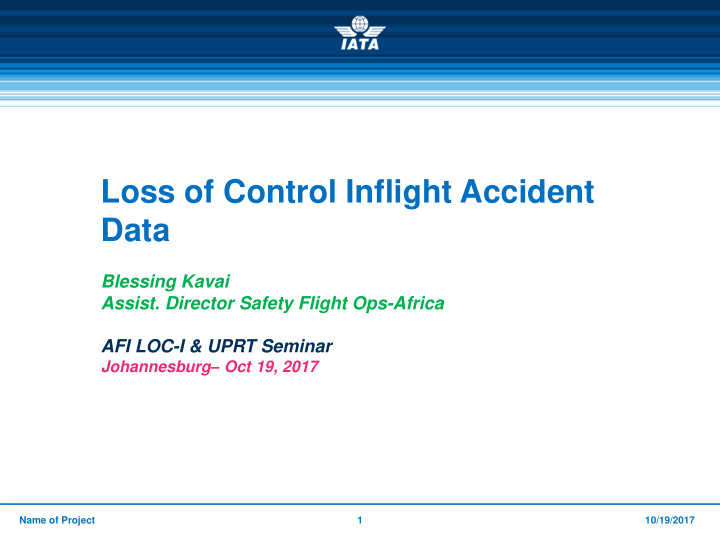



Loss of Control Inflight Accident Data Blessing Kavai Assist. Director Safety Flight Ops-Africa AFI LOC-I & UPRT Seminar Johannesburg – Oct 19, 2017 Name of Project 1 10/19/2017
Loss of Control Inflight Accident Data (2012 -2016)
IATA Safety Data This presentation covers data GADM accident Database using data from January 2012 through December 2016. There were a total of 375 commercial accidents during this period: Of which, 373 could be assigned an accident category or End State 55 Fatal Accidents of which, 54 could be assigned an accident category or End State 1,634 total fatalities
IATA Safety Data Out of the 375 commercial accidents during this period: 30 of these accidents were loss of control inflight 27 of which were fatal accidents and resulted in 949 fatalities
Frequency of Accident Categories
Accident Category Number of Fatal Number of Accidents Accidents Fatalities Loss of Control In-flight (LOC-I) 30 27 949 Top Fatal Controlled Flight Into Terrain (CFIT) 19 16 259 Accident Other End State 12 4 318 Categories Inflight Damage 35 3 86 Runway / Taxiway Excursion 82 3 14 Undershoot 12 1 7
LOC-I Accident Rates per Million sectors per Year
Category 2012 2013 2014 2015 2016 Average 2012-2016 All LOC-I Accident Rate 0.17 0.22 0.16 0.08 0.17 0.16 IOSA vs. Non-IOSA IOSA 0.08 0.09 0.04 0.04 0.07 0.06 Accident Rates Non-IOSA 0.35 0.48 0.40 0.16 0.38 0.35
Distribution of jet / turboprop LOC-I accident rates
Frequency of fatal vs. non-fatal LOC-I Accidents by Phase of Flight
LOC-I Accident Rates by IATA region of operator 11
LOC-I Contributing Factors Errors (related to…) Latent Conditions (deficiencies in...) SOP Adherence / SOP Cross- Flight Operations 32% 41% verification Safety Management 32% Manual Handling / Flight Controls 36% Regulatory Oversight 27% Pilot-to-Pilot Communication 27% Flight Ops: SOPs & Checking 23% Callouts 23% Selection Systems 18% Intentional 23% Environmental Threats Undesired Aircraft States Operation Outside Aircraft Meteorology 36% 32% Limitations Lack of Visual Reference 18% Vertical / Lateral / Speed Deviation 27% Thunderstorms 14% Unnecessary Weather Penetration 18% Flight Controls / Automation Wind/Windshear/Gusty wind 14% 14% Poor Visibility / IMC 14% Abrupt Aircraft Control 14% Airline Threats Countermeasures Aircraft Malfunction 45% Overall Crew Performance 36% Avionics / Flight Instruments 5% Monitor / Cross-check 27% Contained Engine Failure/Powerplant 23% Leadership 27% Malfunction Operational Pressure 9% Captain should show leadership 27% Other 18% Communication Environment 18%
LOC-I: Mitigation strategies for Pilots recognize conditions that increase the likelihood of a stall, and to apply appropriate recovery techniques before stall onset manage distractions and high-workload so that they do not interfere with situational awareness be aware that stall can occur at a lower AOA in icing conditions use effective aeronautical decision-making techniques perform a flight risk assessment prior to each flight
LOC-I: Mitigation strategies for Pilots practice better CRM behavior and cockpit monitoring adherence to established SOPs.
LOC-I: Mitigation strategies for Operators training should not rely too much on certain aircraft flight control protections. Increased focus on training scenarios under degraded flight control protection should be considered efforts to restore and maintain manual flying skills must be comprehensive and ongoing periodic simulator training should include unusual attitude exercises that are realistic to include extremes of center of gravity, weight, altitude, and control status
LOC-I: Mitigation strategies for Operators consider installing of new technology, such as an AOA indicator, which, when coupled with pilot understanding and training on how best to use it, can assist pilots during critical or high-workload phases of flight produce set of standardized FDM safety measures and precursors related to potential LOC-I accidents; such as pitch high during climb, pitch rate high, dual input, thrust asymmetry, early configuration change, and others publish and enforce clear, concise and accurate Standard Operating Procedures (SOPs).
LOC-I: Mitigation strategies Preventative and recovery risk control measures should also be encouraged and implemented by regulators, and manufacturers to help mitigate or avoid the serious consequences of LOC-I.
Recommend
More recommend